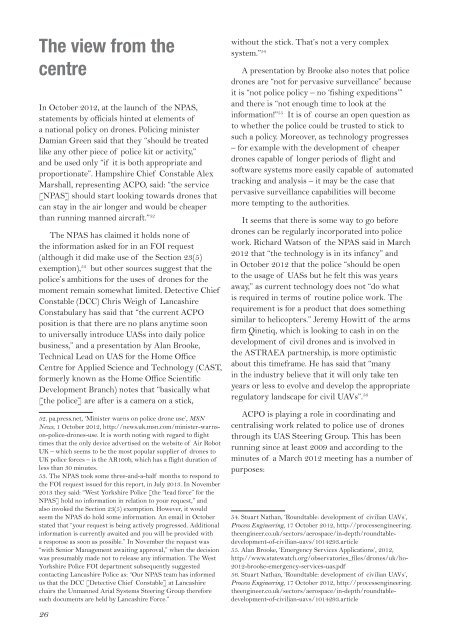Create successful ePaper yourself
Turn your PDF publications into a flip-book with our unique Google optimized e-Paper software.
The view from the<br />
centre<br />
In October 2012, at the launch of the NPAS,<br />
statements by officials hinted at elements of<br />
a national policy on drones. Policing minister<br />
Damian Green said that they “should be treated<br />
like any other piece of police kit or activity,”<br />
and be used only “if it is both appropriate and<br />
proportionate”. Hampshire Chief Constable Alex<br />
Marshall, representing ACPO, said: “the service<br />
[NPAS] should start looking towards drones that<br />
can stay in the air longer and would be cheaper<br />
than running manned aircraft.” 52<br />
The NPAS has claimed it holds none of<br />
the information asked for in an FOI request<br />
(although it did make use of the Section 23(5)<br />
exemption), 53 but other sources suggest that the<br />
police’s ambitions for the uses of drones for the<br />
moment remain somewhat limited. Detective Chief<br />
Constable (DCC) Chris Weigh of Lancashire<br />
Constabulary has said that “the current ACPO<br />
position is that there are no plans anytime soon<br />
to universally introduce UASs into daily police<br />
business,” and a presentation by Alan Brooke,<br />
Technical Lead on UAS for the Home Office<br />
Centre for Applied Science and Technology (CAST,<br />
formerly known as the Home Office Scientific<br />
Development Branch) notes that “basically what<br />
[the police] are after is a camera on a stick,<br />
52. pa.press.net, ‘Minister warns on police drone use’, MSN<br />
News, 1 October 2012, http://news.uk.msn.com/minister-warnson-police-drones-use.<br />
It is worth noting with regard to flight<br />
times that the only device advertised on the website of Air Robot<br />
UK – which seems to be the most popular supplier of drones to<br />
UK police forces – is the AR100b, which has a flight duration of<br />
less than 30 minutes.<br />
53. The NPAS took some three-and-a-half months to respond to<br />
the FOI request issued for this report, in July 2013. In November<br />
2013 they said: “West Yorkshire Police [the “lead force” for the<br />
NPAS] hold no information in relation to your request,” and<br />
also invoked the Section 23(5) exemption. However, it would<br />
seem the NPAS do hold some information. An email in October<br />
stated that “your request is being actively progressed. Additional<br />
information is currently awaited and you will be provided with<br />
a response as soon as possible.” In November the request was<br />
“with Senior Management awaiting approval,” when the decision<br />
was presumably made not to release any information. The West<br />
Yorkshire Police FOI department subsequently suggested<br />
contacting Lancashire Police as: “Our NPAS team has informed<br />
us that the DCC [Detective Chief Constable] at Lancashire<br />
chairs the Unmanned Arial Systems Steering Group therefore<br />
such documents are held by Lancashire Force.”<br />
26<br />
without the stick. That’s not a very complex<br />
system.” 54<br />
A presentation by Brooke also notes that police<br />
drones are “not for pervasive surveillance” because<br />
it is “not police policy – no ‘fishing expeditions’”<br />
and there is “not enough time to look at the<br />
information!” 55 It is of course an open question as<br />
to whether the police could be trusted to stick to<br />
such a policy. Moreover, as technology progresses<br />
– for example with the development of cheaper<br />
drones capable of longer periods of flight and<br />
software systems more easily capable of automated<br />
tracking and analysis – it may be the case that<br />
pervasive surveillance capabilities will become<br />
more tempting to the authorities.<br />
It seems that there is some way to go before<br />
drones can be regularly incorporated into police<br />
work. Richard Watson of the NPAS said in March<br />
2012 that “the technology is in its infancy” and<br />
in October 2012 that the police “should be open<br />
to the usage of UASs but he felt this was years<br />
away,” as current technology does not “do what<br />
is required in terms of routine police work. The<br />
requirement is for a product that does something<br />
similar to helicopters.” Jeremy Howitt of the arms<br />
firm Qinetiq, which is looking to cash in on the<br />
development of civil drones and is involved in<br />
the ASTRAEA partnership, is more optimistic<br />
about this timeframe. He has said that “many<br />
in the industry believe that it will only take ten<br />
years or less to evolve and develop the appropriate<br />
regulatory landscape for civil UAVs”. 56<br />
ACPO is playing a role in coordinating and<br />
centralising work related to police use of drones<br />
through its UAS Steering Group. This has been<br />
running since at least 2009 and according to the<br />
minutes of a March 2012 meeting has a number of<br />
purposes:<br />
54. Stuart Nathan, ‘Roundtable: development of civilian UAVs’,<br />
Process Engineering, 17 October 2012, http://processengineering.<br />
theengineer.co.uk/sectors/aerospace/in-depth/roundtabledevelopment-of-civilian-uavs/1014293.article<br />
55. Alan Brooke, ‘Emergency Services Applications’, 2012,<br />
http://www.statewatch.org/observatories_files/drones/uk/ho-<br />
2012-brooke-emergency-services-uas.pdf<br />
56. Stuart Nathan, ‘Roundtable: development of civilian UAVs’,<br />
Process Engineering, 17 October 2012, http://processengineering.<br />
theengineer.co.uk/sectors/aerospace/in-depth/roundtabledevelopment-of-civilian-uavs/1014293.article


